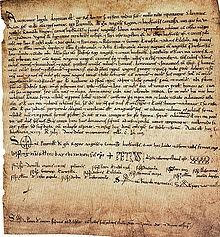Petronilla of Aragon
| Petronilla | |
|---|---|
Countess of Barcelona | |
| Reign | 1162 – 1164 |
| Predecessor | Ramon Berenguer IV |
| Successor | Alfonso II of Aragon |
| Regent of Aragon | |
| Regency | 1164 – 1173 |
| Monarch | Alfonso II |
| Born | 29 June 1136 Huesca |
| Died | 15 October 1173 (aged 37) Barcelona |
| Burial | |
| Spouse | |
| Issue |
|
Jiménez | |
| Father | Ramiro II of Aragon |
| Mother | Agnes of Aquitaine |
| Signature |  |
Petronilla (29 June
Early life
Born in August 1136, Petronilla was the daughter of Ramiro II of Aragon and Agnes of Aquitaine.
Petronilla's marriage was a very important matter of state. The nobility had rejected the proposition of
Queen regnant
At El Castellar on 13 November 1137, Ramiro abdicated, transferred authority to Ramon Berenguer, and returned to monastic life.[6] Ramon Berenger de facto ruled the kingdom using the title of "Prince of the Aragonese" (princeps Aragonensis).
In August 1150, when Petronilla was fourteen, the betrothal was ratified at a wedding ceremony held in the city of
While her husband was away in Provence (1156–57), where he was regent (since 1144) for the young Count
After her husband's death in 1162, Petronilla received the prosperous County of Besalú and the Vall de Ribes for life. As a widow, she was the only ruler of Aragon for the next two years.
Regent

Even after the death of her husband Ramon Berenguer IV, the titles of Petronilla were Queen of Aragon and
Petronilla died in Barcelona in October 1173 and was buried at Barcelona Cathedral; her tomb has been lost. After her death, Besalú and Vall de Ribes reverted to the direct domain of the count of Barcelona, her son Alfonso, who by 1174 had bestowed Besalú on his wife, Sancha.[12] In the Ribes, the local bailiff, Ramon, had carved out for himself "a virtually independent administrative authority" there. He had conducted an inventory for Petronilla after Raymond Berenguer's death, and his son and namesake was in power in 1198.[13]
Legacy
In 1410, after the death of
There is a long debate whether Petronilla was the true ruler of Aragon. Some claim that Ramiro II gave the kingdom of Aragon to his son-in-law and that the presence of Petronilla was secondary. According to
References
- ^ "Gran Enciclopedia Aragonesa". Archived from the original on 2016-03-06. Retrieved 2009-10-18.
- ^ Antonio Ubieto Arteta (1987), Historia de Aragón: creación y desarrollo de la corona de Aragón (Zaragoza: Anubar), p. 131.
- ISBN 978-84-9704-392-2
- ^ Tomás Ximénez de Embún y Val [in Spanish] (1878). Ensayo histórico acerca de los orígenes de Aragón y Navarra (in Spanish). Impr. del Hospicio. p. 258.
Doña Petronila, 1137-1164.
- ^ a b c d e Waag 2022, p. 97.
- ^ a b Reilly 1998, p. 61.
- ^ Reilly 1998, p. 109.
- ^ Reilly 1998, p. 118.
- ^ Colección de documentos inéditos del Archivo General de la Corona de Aragón. Vol. 4. J.E. Montfort. 1848. p. 202.
Ad cunctorum noticiam volumus pervenire quoniam ego Peronella regina aragonensis jacens et in partu laborans apud Barchinonam.
- ^ Bisson 1984, p. 50.
- ^ Colección de documentos inéditos del Archivo General de la Corona de Aragón. Vol. 4. J.E. Montfort. 1848. p. 391.
Quapropter in Dei eterni regis nomine ego Petronilla Dei gratia aragonensis regina et barchinonensis comitissa
- ^ Bisson 1984, p. 179.
- ^ Bisson 1984, p. 185.
- ^ Cristina Segura Graió, "Derechos sucesorios al trono de las mujeres en la Corona de Aragón" Mayurqa 22 (1989): 591–99.
Sources
- Bisson, T. N. (1984). Fiscal Accounts of Catalonia under the Early Count-Kings (1151–1213). University of California Press.
- Bisson, Thomas N. The Medieval Crown of Aragon: A Short History. Oxford: Clarendon Press, 2000.
- Chaytor, Henry John. A History of Aragon and Catalonia. London: Methuan, 1933.
- Hirel-Wouts, Sophie. "Cuando abdica la reina... Reflexiones sobre el papel pacificador de Petronila, reina de Aragón y condesa de Barcelona (siglo XIII)", e-Spania, vol. 20 (2015), retrieved 8 June 2016.
- Reilly, B. F. (1998). The Kingdom of León-Castilla Under King Alfonso VII, 1126–1157. University of Pennsylvania Press.
- Stalls, William C. "Queenship and the Royal Patrimony in Twelfth-Century Iberia: The Example of Petronilla of Aragon", Queens, Regents and Potentates, Women of Power, vol. 1 (Boydell & Brewer, 1995), 49–61.
- Waag, Anaïs (2022). Church, Stephen D. (ed.). "Rulership, Authority, and Power in the Middle Ages: The Proprietary Queen as Head of Dynasty". Anglo-Norman Studies XLIV: Proceedings of the Battle Conference 2021. The Boydell Press: 71–104.
External links
 Media related to Petronila of Aragon at Wikimedia Commons
Media related to Petronila of Aragon at Wikimedia Commons
